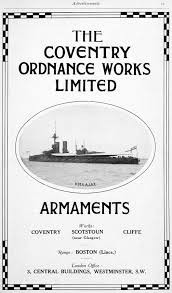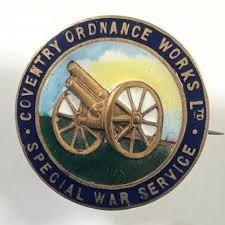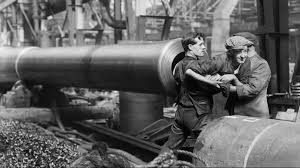
With the redevelopment of the Ordnance Works in Foleshill likely to come up in the next year or so, historian and CovSoc member Peter James reminds us of the history of one of Coventry’s biggest factories. Peter writes…..
The Coventry Ordnance Factory played a key role in British arms manufacturing during the 20th century shaping both world wars and influencing industrial practices across the country. The factory saw the introduction of female labour during WW1 and helped women win the right to vote.
Formation and early years
In the early twentieth century there were two major arms suppliers in the UK, Vickers and Armstrong Whitworth. The Coventry Ordnance Works Ltd. was formed in July 1905, encouraged by the British Government to provide competition to these two. It was a consortium owned by John Brown (50%) Cammell Laird (25%) and Fairfield (25%). The business operated from a 62-acre site on Stoney Stanton Road.
Expansion and Innovation
The company expanded and soon had sites in Scotstoun for gun mountings, Cliffe for shell filling and Boston with a gun proving ground.
They produced an extensive range of artillery for the Royal Navy which included large guns and turrets. These were fitted to battleships and cruisers. Field artillery for the British Army was principally howitzers:- the QF 4.5-inch howitzer entered service in 1910 and the 15-inch siege howitzer followed in 1914. Later in 1917 a 37 mm gun was released which was one of the first automatic cannons.
Production Methods
Around 1906 a new system was introduced where up to 20 portable machines could be moved to operate on a large item during manufacture. The introduction of portable machines revolutionised heavy manufacturing allowing for greater efficiency and adaptability
World War 1 Contributions
With the outbreak of war, the Coventry Ordnance Factory expanded rapidly employing 6000 men and 3000 women. In order to retain workers, the company issued “ON WAR SERVICE” medals, recognising their essential role on the home front. This was to counter the “White Feather Movement” launched in August 1914.
Admiral Charles Penrose Fitzgerald encouraged women to hand out white feathers to men who hadn’t enlisted. This was intended to publicly brand men not in military uniform as cowards. The factory’s output of artillery and howitzers was crucial to the British military effort, While the presence of women in industrial roles marked a significant social shift.

Men machining gun barrels
Inter-war Period
The company saw a rapid decline in orders and was taken over in 1919 by English Electric who continued to manufacture the same type of products. The business was not sustainable causing the Coventry Ordnance Works to close in 1925.
World War 2 Revival
The Ordnance Works were recommissioned in the late 1930s by the British government with production using existing facilities. It was part of the national rearmament programme which commenced in 1936. Contracts for guns and mountings were placed and supervised by the Ministry of Supply and the Admiralty.

Women were employed in order to replace men who had joined the armed forces. They filled a number of positions including packing fuse heads, assembly work and inspection of large gun barrels. The picture above shows male colleagues helping a woman who had been inspecting the inside of a gun barrel. The introduction of female labour was vital in meeting production targets during wartime where women demonstrated their capabilities. They contributed to the war effort with pride, breaking traditional gender roles on the factory floor.
A 15′ Naval gun seen leaving The Royal Ordnance Works at Stoney Stanton Road Coventry. Circa 1915
Post War Legacy
The company continued as a major player in the British heavy engineering sector. It diversified and in addition to producing armaments it went on to supply heavy machine tools and electricity generating equipment. The site was home to some of the largest machine tools in the U.K. An example was a vertical boring mill with a 36 foot diameter turntable which was adapted to produce turbine casings for hydro electric projects. In 1969 the site was sold to Albion Motors an automotive manufacturer.
Coventry Ordnance Works was a major supplier of armaments and heavy engineering products which made a significant contribution during two world wars. It was responsible for both developments in manufacturing and changes in industrial working practices.
